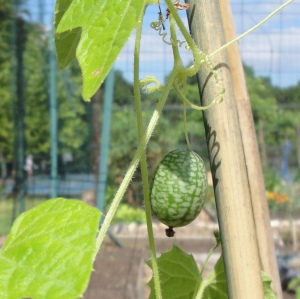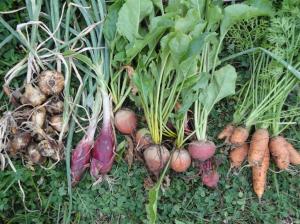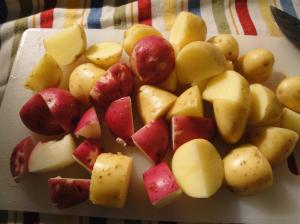Phew. After posts detailing my garden’s tomatoes, root vegetables, nightshades and cucurbits, I am finally ready to close the loop on my summer round-up. The remaining vegetables are mostly brassicas and herbs, with a few other randoms in the mix.
Collard Greens: I got one good harvest of collards early in the summer, which my southern friend cooked up into a delicious mass of slow-braised greens. But then the whiteflies moved in, and the collards got covered in eggs and must. I’ll wait and see if they bounce back in the fall, but right now I’m leaning towards not growing these again next year.
Kale: Ehh, I wasn’t really interested in harvesting the kale this summer – I think of it as more of a fall and winter vegetable. The kale plants did okay, although they did eventually get a modest amount of whitefly affliction. But the kale’s real test will be this fall, when I’m hoping it will be productive past the first frost.
 Swiss Chard: This leafy relative of the beet is my hero. It produced big leaves with meaty stalks all summer long without bolting, and I’m told it will keep producing until late into the fall. I love chard sauteed, in soups, in omelettes, on pizza, in anything, really. It’s great. If I grow any more of it, I will have way too much. But somehow I feel compelled to plant more because it’s been so successful.
Swiss Chard: This leafy relative of the beet is my hero. It produced big leaves with meaty stalks all summer long without bolting, and I’m told it will keep producing until late into the fall. I love chard sauteed, in soups, in omelettes, on pizza, in anything, really. It’s great. If I grow any more of it, I will have way too much. But somehow I feel compelled to plant more because it’s been so successful.
Basil: Another winner. I planted Italian basil, lemon basil, and Thai basil, and all thrived in the heat. I have a freezer full of pesto now, made from the mountains of excess basil that had started to bolt. Next year I think I’ll plant about the same amount of basil, although I’d like to do a better job of staggering the plantings so that I don’t have such a boom-bust cycle.
Tarragon: I planted this fine French herb in a little pot, and it did fine, but I never really used it. I like the flavor of tarragon, but somehow I never find myself making recipes that call for it.
Lemongrass: This was a dud, but I blame the supplier. I ordered a lemongrass start through the mail, and it never divided out into more than the one original stalk. But there was a local supplier of lemongrass starts at the farmers market back in the spring, and they looked a lot healthier. So I might try this again next year.
Parsley: It’s impossible to screw up parsley. This plant flourished, and now looks to be seeding itself for next year. Hooray.
Thyme: Someone left a giant old thyme bush in the community garden’s compost pile, so I divided off a section of it and put it into my permanent herb collection. It’s done great, and will easily survive the winter.
Rosemary: I am very much hoping my rosemary has gotten established enough to get through the winter. Back in Boston my rosemary plants would always die in the cold. But this plant has done well, and I put it in a corner of the garden where it’s okay if it becomes a giant bush.















